How to create email blasts without spamming your audience

It’s 2012, and Obama just struck email marketing gold with the year’s most successful subject line: “Hey.”
Your manager reads an article about it in the latest AdWeek and calls a team meeting to discuss how you can replicate the presidential campaign’s $690M email marketing success.
The team spends most of the meeting deconstructing the email’s copy and design. After an hour of brainstorming, you reach consensus on creative direction.
But you have one more question before you start. As most of your teammates rush out the door for lunch, you stop your manager and ask, “Oh, and who are we sending this to?”
“Everyone,” your manager says. “Just blast it to everyone on our list.”
And, because it’s 2012 and email blasts happen all the time, you do.
Now, more than a decade later, here you are reading another article about email blasts—except a lot has changed, and your manager’s 2012 advice wouldn’t stand up against today’s email deliverability standards.
Conventional email blasts are ineffective because they’re often not relevant to the majority of people who receive them.
Conventional email blasts are ineffective because they’re often not relevant to the majority of people who receive them. Even worse, they can harm your brand’s sender reputation and deliverability with email providers.
When you send enough email blasts, you train your audience into thinking your content doesn’t apply to them. That’s when they start deleting your emails without opening them, unsubscribing altogether, or marking your emails as spam.
But you can avoid that. There’s still a time and a place for a broad(ish) email blast—you just need to take a few extra steps to enjoy the potential revenue they can generate.
Read on to learn what an email blast is, the benefits of sending email blasts, what makes an email blast good, and how to create email blasts that aren’t spammy.
What is an email blast?
An email blast, or e-blast, is the mass distribution of a single email to a large group of recipients. Brands send mass emails like this when they want to deliver a specific message or offer to a wide range of subscribers.
Modern email blasts use personalized content to engage recipients and encourage them to take action. Compelling subject lines, engaging copy, captivating design, and CTA buttons work together to make email blasts as effective as possible.
Email list segmentation and cleaning, however, are what really increases average click-through rate and conversion on email blasts, because they ensure messages are relevant for recipients.
6 benefits of sending email blasts
We like to mock the ol’ bulk emails of yore as much as the next contemporary marketer, but brands that get them right see some benefits from them.
Here are 6 ways email blasts can serve you when you’re doing them right:
1. They save you money
According to Litmus, email marketing earns you $36 for every $1 you spend. If you’re in retail, ecommerce, or consumer goods, that number shoots up to $45.
In other words, email marketing campaigns are cost-effective, and your blasts have the potential to earn you way more money than you spend on them.
The same can’t be said for paid ads, which barely break even for a lot of brands now that most Apple users opt out of the tracking functionality that made audience targeting so specific. Since the feature was introduced in 2021, cost per acquisition has soared and return on ad spend has plummeted.
2. They help you target the right people
Email marketing, and owned marketing in general, is the best way to communicate with people based on how they interact with your brand.
Using Customer-First Data™—the combination of zero- and first-party data—keeps your digital marketing relevant because it allows you to send email messages based on the needs and preferences of each person after they opt in to a relationship with your brand.
And when your owned marketing audience data and email communication are under one roof, you can segment your email blast campaigns based on demographics and behavior like website visits, previous email engagement, previous purchases, etc.
3. They earn measurable results
Email marketing metrics are signals for your brand. You know your email blasts are working if the following metrics are meeting or beating benchmarks:
- Click-through rate (CTR)
- Conversion rate
- Revenue per recipient (RPR)
- Deliverability rates
- Unsubscribe rate
- List growth rate
- Return on investment (ROI)
These metrics are all signals of how close potential customers are to buying, where they are in the funnel, and how much they enjoy hearing from you. When you gain these insights from email blasts, you can transfer them to other marketing channels—and, ultimately, refine your marketing strategy as a whole.
These metrics are all signals of how close potential customers are to buying, where they are in the funnel, and how much they enjoy hearing from you.
4. They increase sales and revenue
Email blasts, or email campaigns, don’t typically earn as much per recipient as email automation flows. But if your content is relevant and your email lists are at least somewhat segmented, you can make up for low RPR with sheer volume.
The most obvious example of an email blast with earning potential is your Black Friday Cyber Monday campaign. While you’ll want to build out special BFCM segments for your VIP customers and previous BFCM purchasers, your overall campaign can skyrocket overall sales with a compelling offer.
5. They drive repeat purchases
If you’re seeing that existing customers are making repeat purchases by clicking on your email blasts, you’ve collected some encouraging information.
Unlike marketing automations, email blasts aren’t triggered by recipient behavior, so they’re more like periodical reminders that your brand exists. If your customers make a purchase after receiving one of these reminders, that means your brand is top of mind and they had a positive experience with you in the past—which is great news.
If you’re noticing a repeat purchase pattern from your email blasts, that’s your cue to create a “highly engaged” customer segment for more personalized messages in the future (more on this later).
6. They boost brand awareness
Similar to posting on social media and receiving engagement from your followers, email blasts create more brand awareness among those who have shown casual interest in your brand.
Contests, quizzes, and incentives to share, when baked into your email blasts, are powerful brand awareness mechanisms that can benefit you over time.
What makes an email blast good?
Relevance is what makes any marketing email good. Our inboxes are overflowing, and we only have time to pay attention to messages that apply to us.
Our inboxes are overflowing, and we only have time to pay attention to messages that apply to us.
So how do you achieve relevance with an email blast? Let’s break down the elements of relevance:
Segmentation and targeting
There’s “batch and blast” email marketing, and then there’s the thoughtful email blast that uses segmentation and targeting.
“I am always shocked when an ecommerce brand develops an email marketing strategy without utilizing list segmentation,” says Ashley Ismailovski, CRO operations manager, SmartSites.
I am always shocked when an ecommerce brand develops an email marketing strategy without utilizing list segmentation
“What consumers want now is personalized messages that keep them engaged with their favorite brands and allow them to receive only the most relevant content to them,” Ismailovski adds.
Marketers used to blast emails to their entire contact lists, but we now know this isn’t the way. At best, batching and blasting means you risk low email deliverability and low engagement. At worst, it could damage your brand perception among audiences who are annoyed about receiving irrelevant emails.
After auditing over 300+ Klaviyo accounts over the last 3 years…
— Dolapo Sangowawa | Retention Marketing For Ecom (@itsonlydolz) December 13, 2022
The BIGGEST email campaign mistakes I see that lead to audience fatigue & lost reveneue are:
1️⃣Poor quality content
2️⃣No audience content fit
3️⃣No relevant call to action
4️⃣Constant discounting and promotions
Segmentation and targeting are what make your email blasts as relevant as possible. With segmentation, you split your audience into groups that share similar characteristics. Audience segments may be based on:
- Demographics: location, age, gender
- Psychographics: interests, lifestyle, values, beliefs
- Behavior: purchase type, purchase frequency, money spent, product landing page visits, email engagement, reviews
Your target audience segment and your email blast content should play off each other like two instruments in an orchestra. When you customize your email blast for the specificity of an audience segment, you increase that campaign’s relevance—which is the single most important ingredient for its success.
Your target audience segment and your email blast content should play off each other like two instruments in an orchestra.
Check out this example from Rapha, which runs a location-based event campaign using dynamic content blocks. The brand knows their audience wants to attend bike races in their area, so they use location targeting to build banner content that notifies them of events.
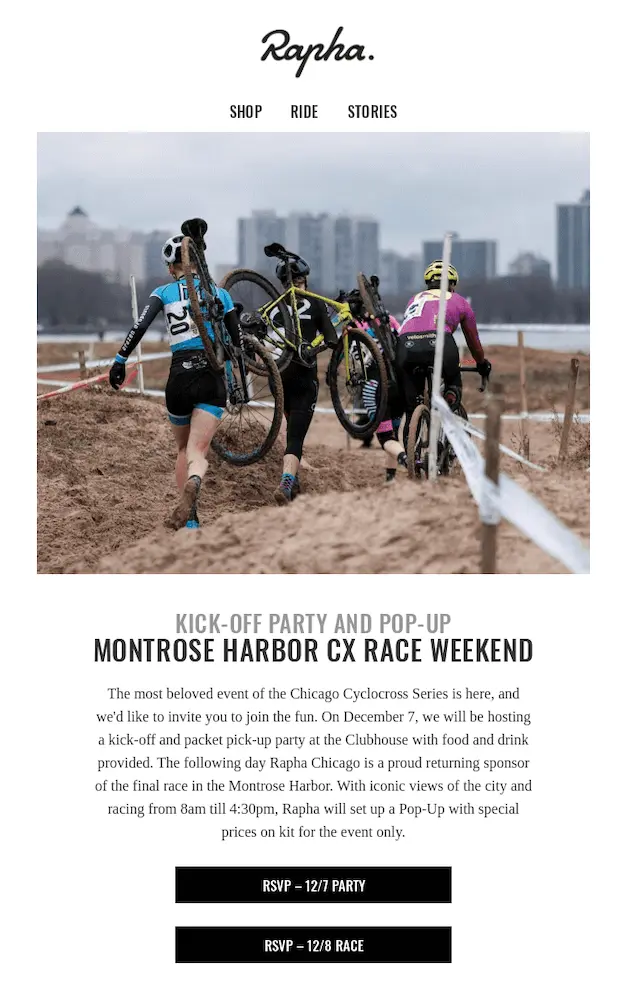
Image source: ReallyGoodEmails
Valuable content
When your email blast segmentation is on point, its content almost instantly becomes more valuable. This is because your audience segment—and your deep knowledge about that segment—guides the contours of your email content, which generally falls into one of 4 categories:
- Educational: Teach the reader something interesting.
- Entertaining: Amuse, delight, and captivate your email subscribers.
- Engaging: Encourage the reader to interact with your brand or take action in some way.
- Inspiring: Use brand storytelling to influence shoppers and motivate them to buy.
No matter which path you choose, the recipient should walk away from your email campaign with a clear understanding of the benefits of your offer.
The recipient should walk away from your email campaign with a clear understanding of the benefits of your offer.
Check out this example from Made In, which uses a how-to video for each product on sale to demonstrate the exact value a customer gets if they take advantage of the last-chance offer.

Image source: ReallyGoodEmails
Attention-grabbing subject line
Email subject lines are the first impressions of your email blasts, so it’s important to get them right. Similar to your content, tailor your subject lines to your audience. Keep them brief while piquing curiosity—and maybe creating some urgency in your subject lines.
Keep in mind that the most effective email subject lines are contextual. At the top of this article, we mentioned Barack Obama’s wildly successful subject line, a simple, “Hey.” This didn’t work because the word “hey” carries some special open rate magic. It worked because people aren’t used to presidents addressing them so casually. President Obama broke a social convention, and it was surprising enough to grab people’s attention.
Something similar is happening in this example from grooming brand Supply, which uses inbox context to craft a creative subject line. The brand knows their email is showing up in overloaded inboxes, and they use that fact to tempt recipients into opening it.
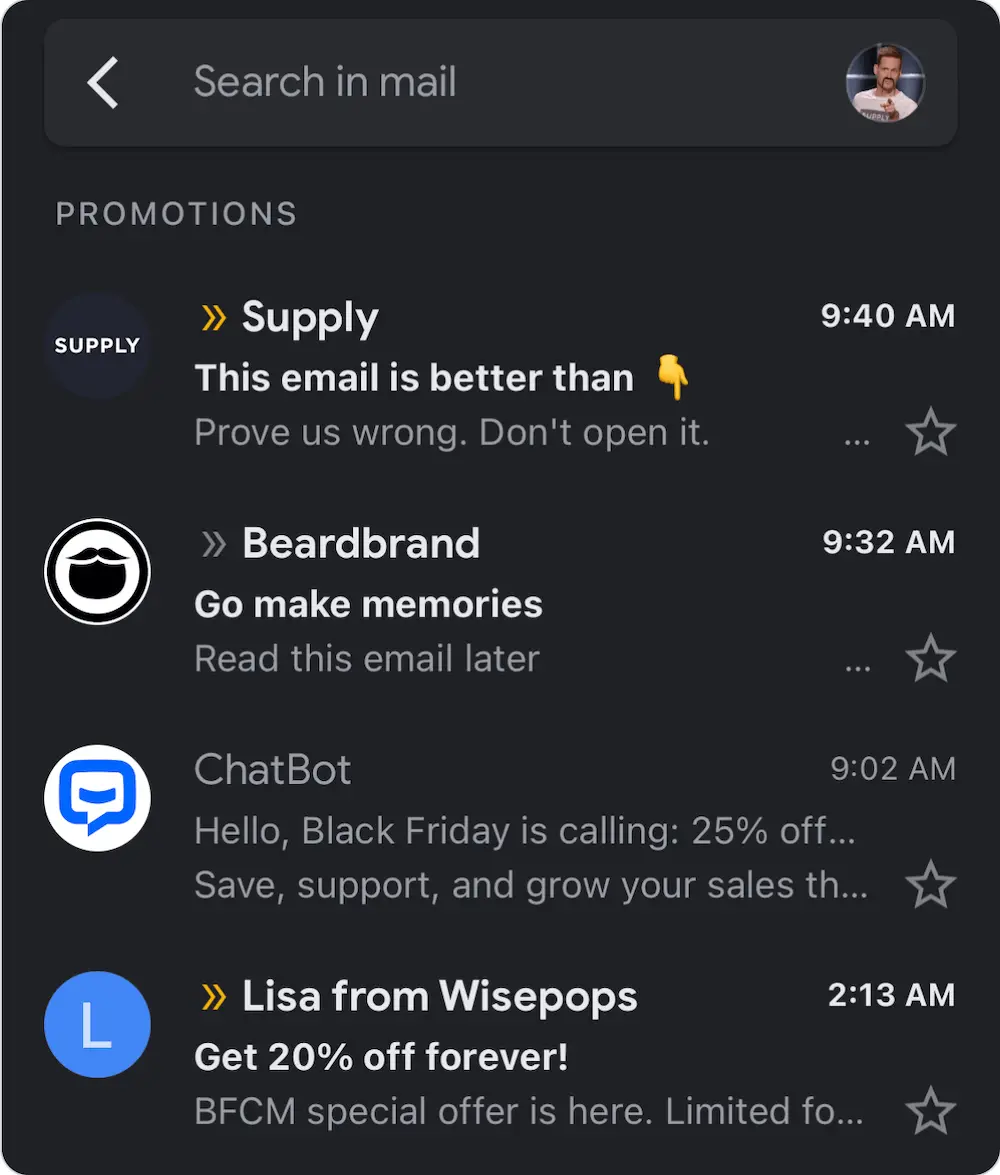
Image source: Twitter
Clear and compelling call to action (CTA)
Email CTAs give your email blasts purpose because they lead to action. Whether that action is to make a purchase or engage with a piece of content, CTAs are designed to grab the reader’s attention and encourage them to interact with the contents of the email.
Purchase CTAs frame the buying experience as one that’s urgent, exclusive, special, or positive.
Aesthetically pleasing design
Email design matters. But its quality is tough to assess because it’s subjective.
But similar to your offer, content, and subject line, good email design is determined by context—and your audience determines your context.
If you know the audience segment you’ve chosen for your email blast is quirky, opt for an unconventional design approach. If your audience, and products, are more utilitarian, go with something cleaner.
If you know the audience segment you’ve chosen for your email blast is quirky, opt for an unconventional design approach. If your audience, and products, are more utilitarian, go with something cleaner.
Mobile optimization
We can no longer accurately measure the number of emails opened on mobile after the introduction of Apple’s Mail Privacy Protection (MPP) in September 2021, but we can deduce that a lot of your email blasts will be viewed on a mobile device. If your emails aren’t optimized for mobile, it could result in an automatic delete.
So what does mobile optimization mean for email? This is what it looks like:
- A single-column layout for easy scrolling and readability
- Responsive email templates that adjust to screen size
- Readable fonts and CTA buttons for easy navigation and interaction on touchscreens
- Small image sizes that don’t slow down load times on mobile devices
This example from pottery brand East Fork shows you don’t need to sacrifice design for mobile optimization. The image is eye-catching (it’s actually a gif), the text is readable, and, most important, the recipient doesn’t need to scroll to get to the CTA. They can open the email and easily tap if it piques their interest.
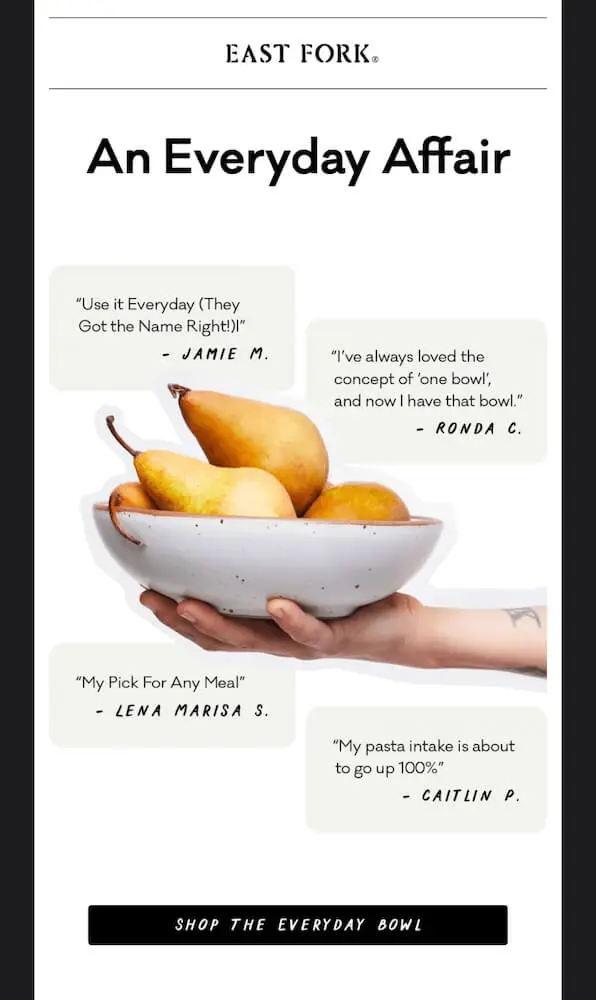
Image source: East Fork
How to create and send email blasts that aren’t spammy
Now that you know the principles behind a good email blast, it’s time to execute. It’ll come as no surprise to you by now that a quality email blast starts with the right audience—which means blasting your entire list is out.
Here’s what to do instead:
Step 1: Choose an audience segment
Engaged audiences take action. Before you plan your email blast, start by isolating your most engaged recipients within your overall list.
What does an engaged audience look like? As a start, engaged audiences are people who either opened or clicked a previous email within the last 30 days and/or anyone who subscribed to your main list in the last 15 days.
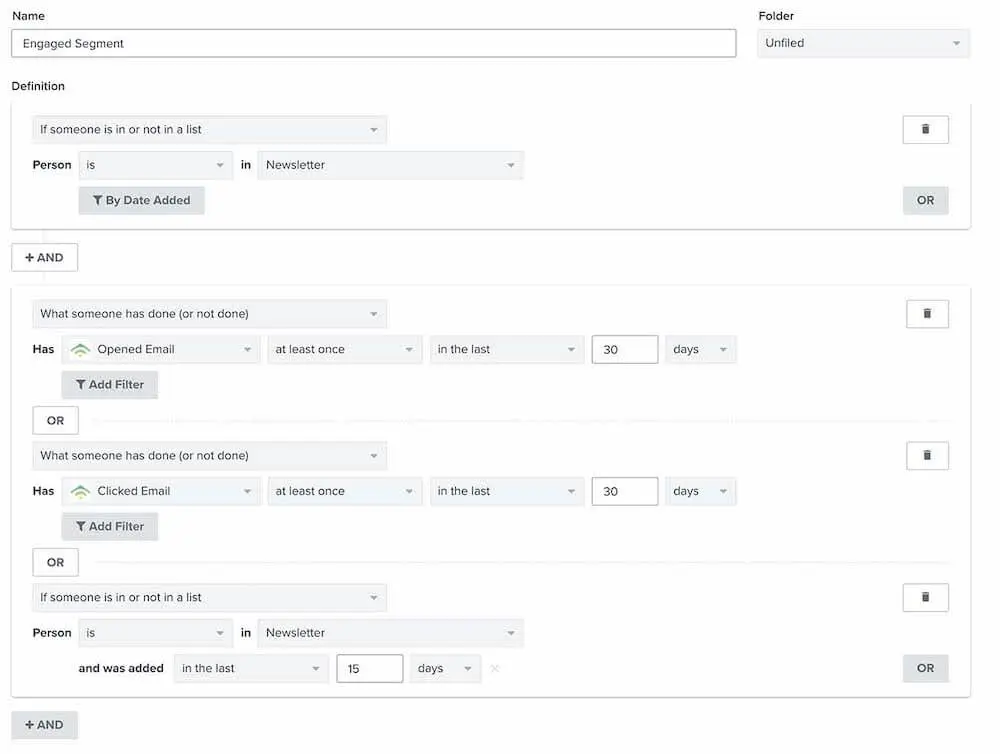
Image source: Klaviyo
If your open rates for this segment fall below 20%, that’s your cue to shrink it down further. You can do this by tightening your timeframe to 14 days, then more until you see your ideal open rate and engagement rate.
After you’ve gone through these steps, you can add more specific criteria to your segment, like purchase history, interests, email habits, location, etc. The more personalized your emails are, the more likely recipients are to open them.
Step 2: Determine your offer
Now that you know who you’re sending to, it’s time to determine what they’ll get.
An effective email blast always answers the question, “What’s in it for me?” from the point of view of the audience, so you want to make sure your offer answers this question with something sweet.
An effective email blast always answers the question, ‘What’s in it for me?’ from the point of view of the audience
Here are some options to consider based on different segments:
People ready to buy
- Discount
- Limited-time sale
- Free gift with purchase
- Limited-quantity deals
- Seasonal promotions
- Personalized recommendations
Existing customers
- Exclusive pre-sale access
- Loyalty rewards
- Referral program access
- Exclusive content or sneak peeks
- VIP membership or access
- Community or forum access
New subscribers
- Online workshop
- Free consultation or assessment
- Giveaways or contests
- Free trial or sample
- Educational resources
Step 3: Write your email content
Effective email copy, including your subject line, is constructed around your audience and your offer. You’re the only one who can decide what your brand sounds like, but this foundational best practice remains true: Your audience is the deciding factor for your email blast content.
3 minute email audit:
— Val Geisler (@lovevalgeisler) January 14, 2021
– open all of your welcome and post-purchase emails
– count the number of times the text reads “we”
– delete those emails and go talk to your customers
Here are a few additional best practices for writing good email content:
- Spend time crafting your subject line. Your subject line should be personalized to the recipient, pique curiosity, and create some urgency.
- Use social proof to build credibility and trust. No offense, but your customers’ words are often better than your own. If you have them, include some glowing customer reviews to build trust with your audience.
- State your value proposition. Use creative brand storytelling to convey your products’ main benefits—and don’t be afraid to pull on some heartstrings. (In rhetoric, this form of persuasion is called “pathos.”)
- Insert a convincing CTA. Use action-oriented language to increase CTRs on your email blast.
No offense, but your customers’ words are often better than your own.
Step 4: Design your email
Your email blast design depends on your goals. If your goal is to showcase new products and give readers a lot of choice, you need an image-heavy design with beautiful product shots to compel people to click. If your offer has nothing to do with your products, a more minimal, text-based design may work better.
Regardless, your basic email template looks something like this:
- Heading
- Hero image
- A short blurb
- CTA button
You may want to deviate from this template because you want to include more product shots, or you want to test a CTA button near the top. Your options are plentiful, but we recommend adhering to some basic principles:
- Include your logo.
- Include your social media links.
- Include an unsubscribe link at the bottom—it’s the law.
- Use images, but don’t stuff your email with so many that it can’t load quickly.
- Experiment with colorful or patterned backgrounds.
- Don’t include more than 3 CTAs.
- Always optimize for mobile—odds are, this is how people will view your email.
One thing to consider: adding video elements to your emails. According to Think with Google, more than half of shoppers say online videos help them decide which brand or product to buy.
Step 5: Send and test your email
If you haven’t tested your email blasts in the past, your send should come with an A/B test.
A/B testing is how you refine email performance, which is especially important when you’re starting from scratch and don’t yet know what works. Some basic examples of A/B tests for email are:
- Testing subject lines for open rate performance
- Testing CTAs for CTR performance
- Testing images and layouts for CTR performance
The golden rule of A/B testing is to test only one element at a time. If you’re testing subject lines, don’t test CTAs at the same time—the double variable will skew your results, and you won’t know what’s responsible for an improvement or drop in performance.
The golden rule of A/B testing is to test only one element at a time.
With an email marketing service like Klaviyo, you can customize your A/B test parameters by audience percentage and time.
For example, you can choose to reserve 20% of your email recipients for variation A, and another 20% for variation B. Depending on how many of your recipients click on the email, a winner emerges after 6 hours—and the rest of the recipients automatically receive the winning variation.

Image source: Klaviyo
Step 6: Analyze your results
You’d be surprised how many people A/B test their email blasts only to ignore the results. But test analysis and iteration are arguably the most important steps in deploying an email blast, second only to segmenting your audience.
So how do you measure the results of your A/B test? After isolating your test variable in step 5, you need to make sure one group’s metrics (likely CTR or open rate) won over the other at a statistically significant rate.
Email marketing software like Klaviyo helps you mathematically determine the reliability of your A/B test results by categorizing A/B test results into 4 groups:
- Statistically significant: The result has a high chance of winning over the other variations in the future.
- Promising: The winning version has a chance of getting more engagement in the future, but you may need to run more A/B tests to make sure.
- Not statistically significant: The winning variation is slightly better than the others, but you may not be able to reproduce the same results if you repeat the A/B test.
- Inconclusive: There isn’t enough information to complete the test. You need to expand your recipient pool or follow up with more tests.
Your goal is to get results that are statistically significant so you feel confident about doubling down on your chosen course of action. When you run enough tests with enough email blasts, patterns start to emerge with different audience segments—and you’ll ultimately know what your audience responds to the most so your email blasts can become even more effective over time.
3 email blast examples
Ben Zettler, founder of Zettler Digital, shares some email blast examples from brands the team works with. “We sent each of the emails below to large sets of subscribers,” he says. “We do that anytime messaging is applicable to a wider audience.”
Zettler shares that for sends of this nature, they typically exclude the following groups:
- Those that have soft bounced once in the last 30 days or at least 3 times previously.
- Subscribers that have placed any order within the last 7 days.
- Subscribers that have bought the particular product being featured within the last 30 days.
Anytime the messaging is applicable to a wider audience, we consider an email blast.
1. Victory Grips sends a notice about an annual scholarship fundraiser to a wide audience
Victory Grips makes supportive gear for athletes, and they sent this product feature ahead of the Murph Challenge, an annual crossfit scholarship fundraiser that lots of crossfit athletes (and their subscribers) participate in.
It’s a classic lesson in how to create an email blast: with multiple CTAs driving to product pages for the new products, the link to the scholarship fundraiser is at the bottom.
This is the perfect example of the right occasion to send an email blast. A meaningful fundraiser that the audience is likely to respond to is absolutely worth the larger send.

Image source: Victory Grips
2. Pura Cashmere restocks a bestselling product—and lets almost everyone know
Pura Cashmere is not afraid to shout good news from the rooftops. When one of their bestselling products, a cotton fisherman crewneck sweater, came back in stock, they sent an email blast to a large group of people.
Not only did they make it clear that the sweater was back in stock, they included imagery of every available color. With CTAs at the top and bottom, it’s a good occasion to do a wide send.
“Sometimes determining if a message is worthy of a wider send is as simple as conducting a gut check,” says Zettler. “Consider your brand and how audiences typically react to certain messaging, as well as how much pent-up demand there may be for that content. Once you’ve figured that out, ask yourself: is it reasonable to assume that a big chunk of your audience is likely to engage with the message?”
If the answer is yes, Zettler says, go ahead and send the message out widely.
Sometimes determining if a message is worthy of a wider send is as simple as conducting a gut check. Ask yourself: is it reasonable to assume that a big chunk of your audience is likely to engage with the message?

Image source: Pura Cashmere
3. Printique announces their Mother’s Day book sales to a large audience
With billions spent in America alone on Mother’s Day each year, it’s a holiday worth the occasional email blast.
Printique sells photo prints, albums, and other tools to help people create personalized photo print products. Ahead of Mother’s Day, they send this email that announces their best gift for mothers: a book to hold memories.
While it’s always a good idea to give people the chance to opt out of Mother’s Day (and Father’s Day) messaging, once you’ve got the list of people who’ve opted in, it’s worth sending them your best products. People often want new and unexpected gifts for their parents and caretakers, and if you’ve got one you’re excited about, an email blast is a good way to get it in front of lots of eyes.

Image source: Printique
Email blast FAQs
Are email blasts spam?
Email blasts aren’t spam if you send to recipients who’ve explicitly opted in to receive your marketing communications. Though if you don’t segment or personalize, they can end up feeling like spam to the wrong audience. Real spam refers to unsolicited emails sent indiscriminately to large groups without permission or consideration of recipient preferences, whereas an email blast means sending a message to every active profile.
How often should I send email blasts?
The optimal frequency for marketing email blasts depends on your industry, audience preferences, and content quality. Most successful email marketers send 1-2 emails per week, which balances staying top-of-mind without overwhelming subscribers. Test different frequencies and monitor your open rates, click-through rates, and unsubscribe rates to find your audience’s sweet spot. Whatever cadence you choose, consistency is key—irregular sending patterns can confuse subscribers and decrease engagement. Always prioritize providing genuine value with each email rather than focusing solely on frequency.
What is the best time to send email blasts?
Research suggests that Tuesday through Thursday mornings (around 10 AM to 12 PM) and afternoons (1 PM to 3 PM) in the recipient’s local time zone typically yield the highest engagement rates. However, the optimal sending time varies significantly based on your specific audience demographics, industry, and the nature of your content. The most reliable approach to learn how to send email blasts at the right time is to conduct A/B tests with your own audience and analyze your email performance data to determine the most effective sending times for your particular subscribers.
What is considered a good open rate for email blasts?
Klaviyo’s benchmarks report that open rates typically land above 35%, though this benchmark can vary significantly depending on your specific sector, audience size, and list quality. Rather than focusing solely on industry averages, track your own performance over time and aim for consistent improvement relative to your historical data. And remember: open rates have been notoriously unreliable since iOS 15.
It’s your email blast audience that makes the difference
A successful email blast isn’t so broad that it’s not relevant. It takes into account what you know about your audience and gives them something they need.
Study the elements of high-performing email blasts, and your analysis may yield new audience segments that boost your email marketing revenue across multiple campaigns.

Related content
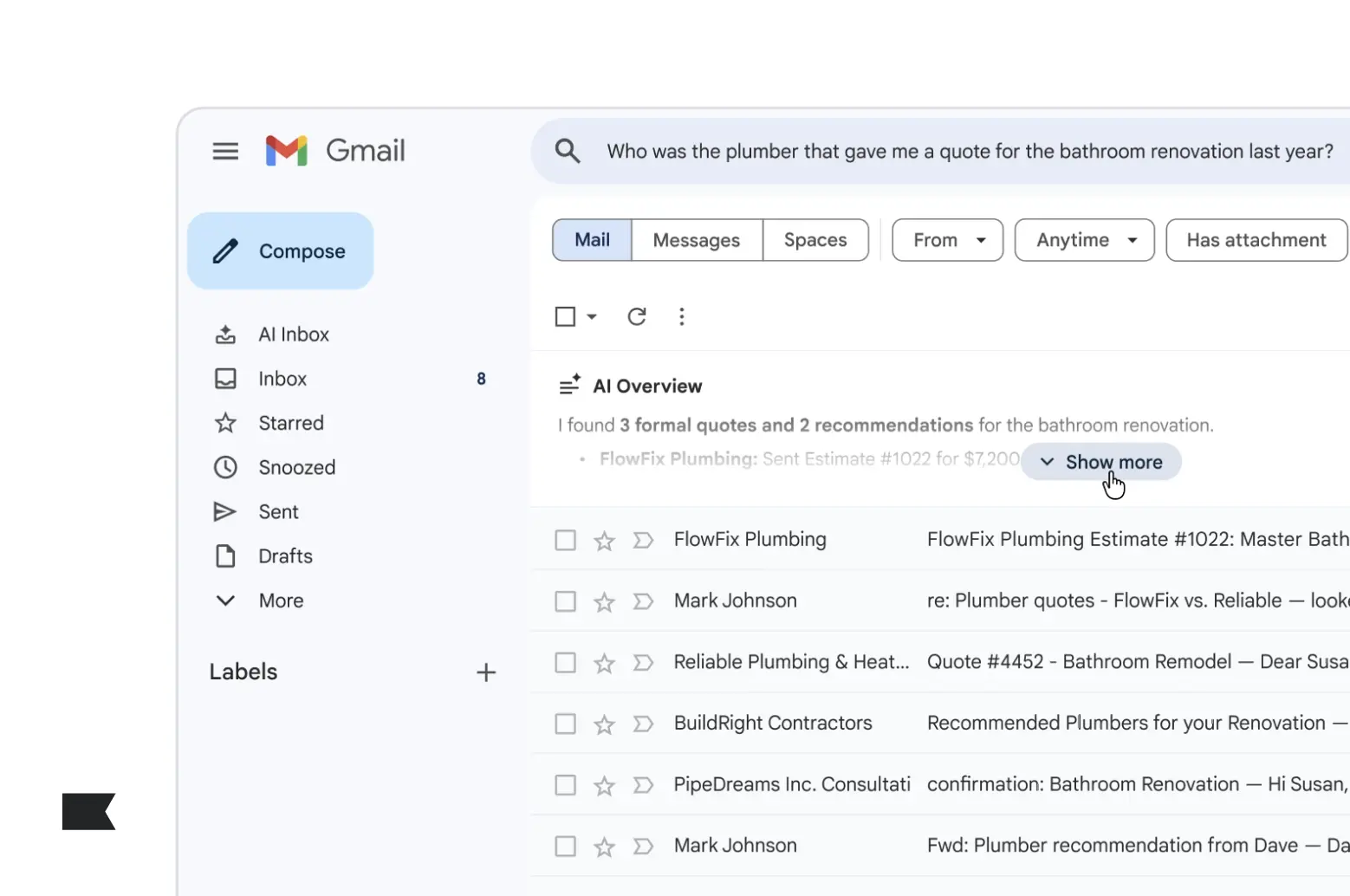
Google is bringing Gemini AI directly into Gmail, changing how emails are summarized, prioritized, and acted on. Here’s what retail marketers need to know—and how to adapt.

Discover the best email marketing platform for ecommerce in 2026. Compare top tools for data, automation, personalization, and deliverability.
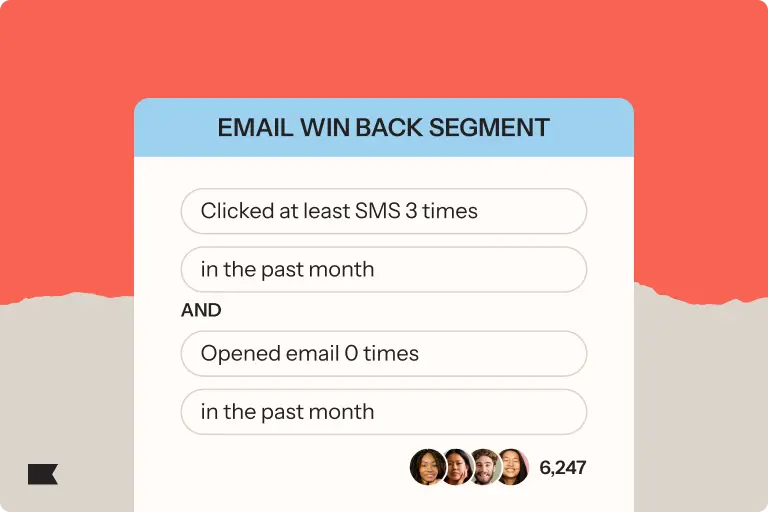
Learn how to use Klaviyo SMS, segmentation, and hybrid flows to re-engage lapsed email subscribers, boost deliverability, and drive higher retention.